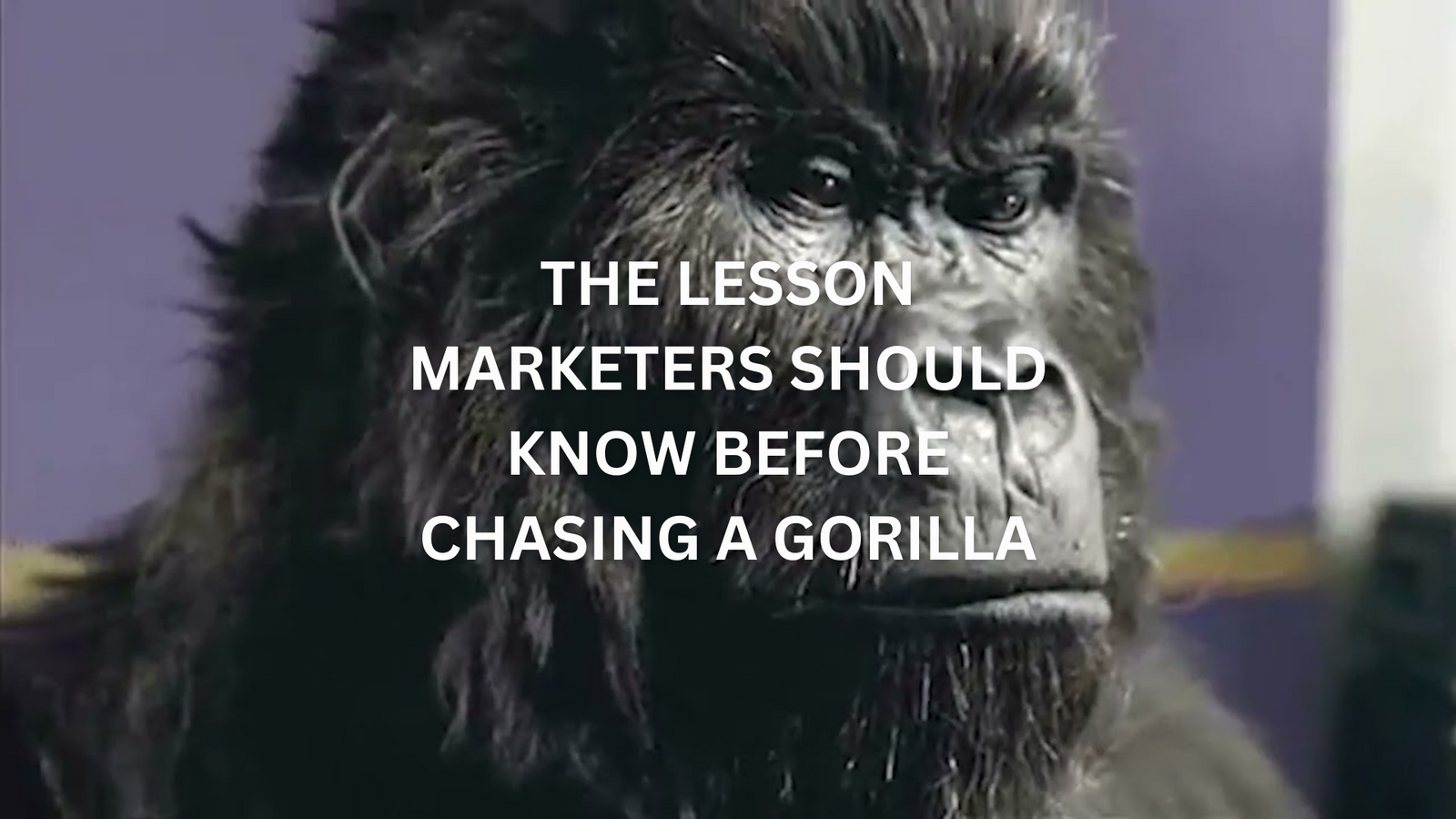Cadbury’s Gorilla Campaign: A One-of-a-Kind Marketing Triumph That Brands Can’t Replicate

Nearly two decades on from Cadbury's Gorilla campaign it continues to be lauded as one of the all-time greats. Looking back it looks like it was always destined to by a triumph, but hindsight is 20/20.
Cadbury’s Gorilla campaign redefined what advertising could be: unconventional, product-free, and emotionally driven. The drumming gorilla, set to Phil Collins’ In the Air Tonight, became a cultural phenomenon (and still is to some degree), boosting sales and reshaping Cadbury’s brand image.
But why was it so successful, and while other brands have had their breakout moments, few have ever been so bold as to not mention their brand, their product or what they stood for, since.
Behind Gorilla’s acclaim, was a company with a reputation to re-build, little to lose and a desire to create something special, but not create a viral behemouth.
Like this post? Want to be the first to get more like it? Subscribe to our newsletter for free.
Want to take your marketing performance to new heights? We can help.
The Genesis of the Gorilla Campaign
In the mid-2000s, Cadbury faced significant challenges. A salmonella scare had tarnished its reputation, leading to a decline in consumer trust and sales. In response, Cadbury sought to rejuvenate its brand image.
Partnering with the advertising agency Fallon London, they aimed to create a campaign that would restore public faith and reinvigorate the brand. Juan Cabral, the creative mind at Fallon, pitched the "Gorilla" concept - a departure from traditional chocolate advertising.
Despite initial reservations, Cadbury's marketing director, Phil Rumbol, recognised its potential. Reflecting on the pitch, Rumbol noted, "When we heard the script I just remember myself and my team walking into the side room and grinning from ear to ear. I didn’t necessarily fully understand why but I knew in that instant we just had to do it."
The Unconventional Approach
The "Gorilla" advertisement broke several conventions:
Product Absence: For the majority of the ad, there was no mention or visual of Cadbury chocolate.
Emotional Engagement: The focus was on eliciting joy and surprise, rather than promoting product features.
Viral Potential: Its uniqueness encouraged viewers to share and discuss the ad, amplifying its reach organically.
This strategy aligned with Fallon's vision to produce "entertainment pieces" that would resonate on a broader scale, moving away from traditional, product-centric advertisements.
Impact and Reception
Upon its release, the "Gorilla" ad became a cultural phenomenon. It garnered over 500,000 views on YouTube within the first week and spurred numerous parodies and discussions across various platforms.
The advertisement's success translated into tangible benefits for Cadbury. Cadbury reported a 9% increase in Dairy Milk sales following the campaign's launch, and the public perception of the brand improved significantly, with more consumers viewing Cadbury favorably.
The ad's success was further validated by numerous awards, including the prestigious Film Grand Prix Lion at Cannes Lions 2008.
Hypotheses for Its Acclaim
Several factors contributed to the "Gorilla" campaign's widespread acclaim:
Emotional Resonance - The ad tapped into universal feelings of joy and surprise, creating a memorable experience that resonated with a wide audience.
Novelty and Surprise - Its unexpected nature broke through the advertising clutter, capturing attention and sparking curiosity.
Cultural Relevance - The use of a classic song like "In the Air Tonight" bridged generational gaps and added a layer of nostalgia.
Strategic Risk-Taking - Cadbury's willingness to deviate from conventional advertising norms demonstrated boldness, which paid off in brand rejuvenation.
The ‘Gorilla Moment’: A Sign of Bravery or Trouble?
Many marketers and many more creative directors call for brands to be as brave as Cadbury, calling for marketers to have their own ‘Gorilla moment’.
Cadbury's Gorilla campaign is, after all a creative's dream brief, and in hindsight appears to be a guaranteed success. The campaign was so bold, so unexpected, and so widely loved that it becomes a cultural touchpoint.
Many forget that Cadbury’s Gorilla campaign was born out of necessity, a reaction to reputational damage that required a drastic shift in perception. But does the need for such a moment indicate trouble?
If a brand finds itself in a position where it must take a radical leap, is that a sign that traditional approaches are failing? Worse, is it a sign to the public that the brand actually is in trouble?
For brands at a crossroads - whether facing declining sales, a reputational crisis, or simply losing relevance - the temptation to ‘go big’ can be overwhelming. However, true bravery in marketing isn't just about making a bold move; it’s about making the right bold move.
A Gorilla moment cannot be manufactured. It requires impeccable timing, audience insight, and the willingness to let creativity take the wheel. The question remains: should brands seek their Gorilla moment, or does the very act of searching for one suggest a deeper problem?
Interestingly, Cadbury itself moved away from the abstract style of the "Gorilla" ad in subsequent campaigns. The company realised that while the ad was memorable, it didn't necessarily convey the brand's core values.
Ben Wicks, Cadbury's global brand director, noted that the brand became "fixated" on finding the next "Gorilla" rather than conveying what Cadbury was about.
Cadbury’s Leap of Faith: Why ‘Gorilla’ Can’t - Perhaps Shouldn't - Be Replicated
Cadbury’s Gorilla campaign wasn’t just bold - it was unprecedented. Unlike traditional advertising strategies, which often build on past successes, Gorilla was a total departure from the norm. It wasn’t just a creative risk; it was a brand risk. No chocolate, no product features, no tagline - just a drumming gorilla and a feeling of joy. That’s what made it magical.
Any attempt by a brand to deliberately seek out a positive and viral moment with an evocative, off-the-wall campaign may be chasing its own tail. Marketers should remember well that while Cadbury were positive about the campaign before its launch, the response to the campaign took the company completely by surprise.
A ‘Gorilla moment’ works because it is unexpected; once the formula is known, it loses its edge. Attempting to chase a 'Gorilla moment' risks looking derivative, forced, or, worse, desperate.
Even Cadbury itself never recreated Gorilla, despite its success, because it understood that lightning doesn’t strike twice in the same way. True creative leaps, by definition, can’t be repeated.
For brands contemplating a similarly bold move, the lesson isn’t to mimic Gorilla, but to take their own unique leap of faith - one that feels just as fresh, unexpected, and perfectly timed as Cadbury’s did in 2007.
The Final Word
The "Gorilla" campaign stands as a testament to the power of creative risk-taking in advertising, timing and luck. Its success lay in its ability to evoke emotion, break conventions, and create a lasting impression.
However, its uniqueness also highlights the challenges brands face in balancing innovation with brand identity and strategic objectives.
Cadbury set out to create a campaign that was memorable and change the conversation about their brand, they didn't necessarily set out to create a global phenomenon nearly two decades later.
While the "Gorilla" ad remains unparalleled, it should serve as both inspiration for marketers to think outside the box and remember how unconventional approaches can have big risk / reward returns.
Like this post? Want to be the first to get more like it? Subscribe to our newsletter for free.
Want to take your marketing performance to new heights? We can help.
Sources: marketingweek.com , en.wikipedia.org , contagious.com




Leave a comment